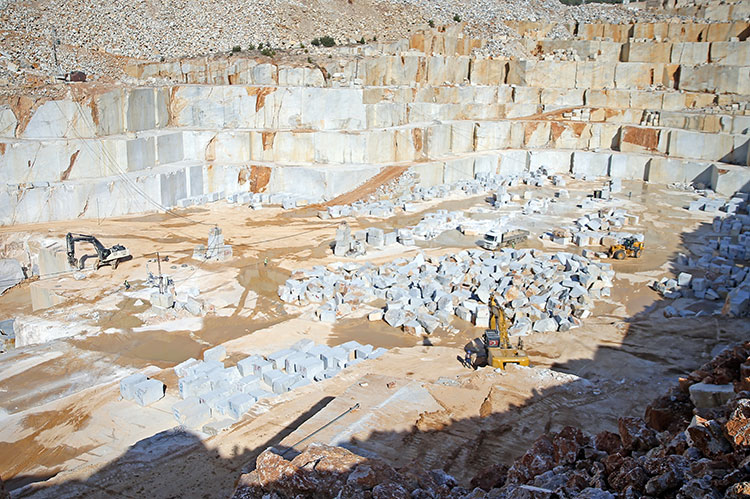Muğla white marble is a natural marble variety extracted from the Yatağan, Milas and Kavaklıdere districts of Muğla province in southwestern Türkiye. Distinguished by its high physical and mechanical strength, it was registered as a “designation of origin” under Industrial Property Law No. 6769 and granted geographical indication protection on April 19, 2020.
Geological Origin and Physical Properties
Muğla white marble is obtained from formations of mesozoic-aged, abrasive-rich platform-type carbonates. Extracted along the Milas-Yatağan-Kavaklıdere line, this marble is noted for its homogeneous structure and low porosity. Its smaller crystal size compared to other marbles facilitates polishing and enhances the durability of the final product.
Key physical and mechanical properties include:
- Mohs Hardness: 3–3.5
- Schmidt Hardness: Average 50 (±3.72)
- Unit Weight: 2.72 g/cm³ (±0.032)
- Porosity: 0.035–0.62%, average 0.22%
- Uniaxial Compressive Strength: Average 101.52 MPa (±12.80)
- Post-Freeze Compressive Strength: Average 88.08 MPa (±9.13)
- Elastic Modulus: 128 GPa
- Wear Rate: 17.70 cm³/50cm²
Its low porosity (0.22%) distinguishes it from other marbles, which typically have porosity around 1–2%, ensuring longevity and resistance to environmental effects.

Muğla White Marble (AA)
Production Process
The production of Muğla white marble occurs in two main stages: quarrying and factory processing.
Quarrying Stage
- Opening Quarry Face: The area is prepared for cutting and drilling after confirming marble availability.
- Drilling Operations: Horizontal and vertical boreholes are drilled.
- Diamond Wire Cutting: Marble is separated from the bedrock using diamond wire.
- Block Extraction: Hydraulic equipment detaches the cut blocks.
- Sizing and Transport: Blocks are cut to suitable dimensions and transported to the factory.
Factory Stage
- Crane Handling: Blocks are moved to the cutting unit.
- Cutting Unit: Circular saw machines process marble for tiles and slabs.
- Head Cutting and Sizing: Marble dimensions are adjusted to final specifications.
- Slab Cutting: Selected blocks are cut into sheets using multi-blade machines.
- Surface Treatment: Polishing, sandblasting, antiquing and honing are applied. Low porosity eliminates the need for filler or drying processes.
- Storage and Shipment: Processed marble is packaged and dispatched.
Inspection and Protection
The production stages are rigorously monitored to ensure compliance with geographical indication standards. The marble’s physical and mechanical properties, color consistency and correct use of logos and designation of origin emblems are inspected. The Muğla Chamber of Commerce and Industry coordinates these inspections and manages legal rights and registration protection.


